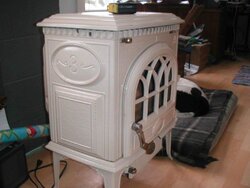We have a Jotul 3, an older model with the catalytic converter. Directions state to get flue temp up to at least 600 degrees before engaging converter. We've used this stove successfully for two winters, usually running flue temp up to 800 degrees on the advice of our installer. So far this fall however, when running the flue temp this high the stove emits a horrible, almost burning rubber smell that permeates the house! The variables: Chimney (a selkirk metalbestos 6") has been rerouted slightly to accommodate a recent addition to the house. Two 30 degree angles were added. The outside height is slightly shorter than before, but well within the two feet higher than anything within ten feet rule. The other variable is that I cleaned the firebox thoroughly with my shopvac, actually dissassembling it (the firebox) to get into all the cracks and crevices. Yes, I did reassemble it properly! By the way, the chimney was just proffesionally cleaned.
Could a failed catalyst be my problem?
Could a failed catalyst be my problem?



 (check out the picture)
(check out the picture)